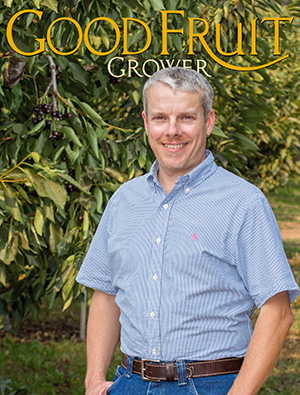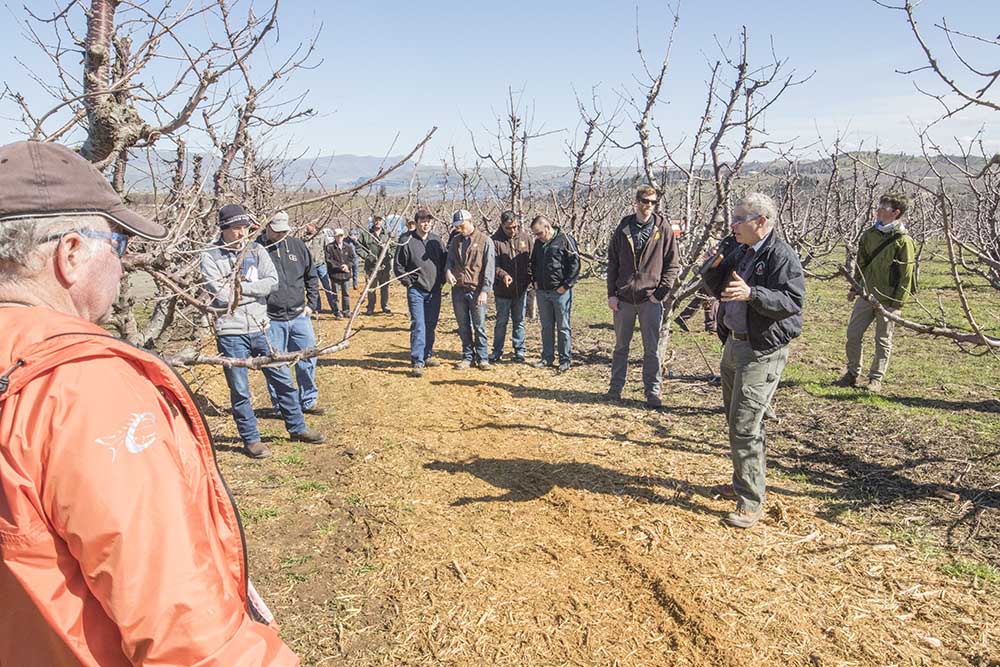The fingerprints of Mike Omeg, 2017 Good Fruit Grower of the Year, are all over the cherry industry.

Omeg, holding a microphone, talks with other growers at one of his orchards overlooking The Dalles Dam during an Oregon State University soils workshop in March 2017. (TJ Mullinax/Good Fruit Grower)
He hosts countless field days and tours, collaborates on numerous research trials, frequently speaks at conferences, and appears in numerous magazine articles describing his techniques and results.
Though he does sometimes decline speaking engagements, both researchers and neighbors tease him about his involvement and publicity.
Among his key collaborators over the years is Lynn Long, the recently retired Oregon State University Extension horticulturist, who partners often with Omeg for trials and field days.
“I’ve joked before that Lynn Long’s preharvest tour should be Mike Omeg’s preharvest tour,” said Matt Whiting, a Washington State University Extension specialist.
Omeg will give the first disclaimer: He doesn’t do any of these things by himself. But he at least is a key collaborator in all of them.
Take a look at this lengthy, but not exhaustive, list of his grower-education accomplishments and projects.
Pest control and beneficial insects
Omeg, who holds a master’s degree in entomology from Oregon State University and a bachelor’s degree in economics at Willamette University with a double minor in environmental sciences and biology, is a champion for alternative methods of pest control.
Mike Omeg, Omeg Family Orchards

As a graduate student in the late 1990s, he developed a growing degree-day model for the control of obliquebanded leafroller, an emerging pest in The Dalles at the time.
Around the year 2000, he helped develop a network of agricultural weather stations called the Integrated Fruit Production Network in the Columbia Gorge.
It’s similar to, though smaller than, Washington State University’s AgWeatherNet and has led to growing degree-day models for other pests.
“It’s still valid and used today as a weather network,” Long said.
Over the years, Omeg has planted plots of flowers to attract native pollinators and beneficial insects around his property. He has built habitat boxes for bats, birds of prey and a variety of insect-eating birds.
He spoke at the 2011 Colorado Horticulture Society about attracting barn owls, and in 2013 he quantified the costs of rodent control in a Good Fruit Grower story.
In 2014, he organized and hosted a workshop about raptors and choosing rodenticides that don’t inadvertently poison the birds of prey. He began using the Verminator, a machine that burrows and sets bait for rodents. He also uses traps to catch unwanted birds, such as starlings and sparrows.
New varieties
Omeg grows about eight or nine cherry cultivars commercially, Bing, Rainier, Sweetheart and Early Robin among them.
But the industry needs new varieties, he said, including a bigger, more productive and rain-resistant replacement for the workhorse Bing. He also wants new varieties to spread out the peak of his harvest costs, avoid heat and rain cracking and offer a large, productive cherry for the market.
He collaborates on a lot of variety and rootstock trials, and holds his own, to gauge cultivars in his own growing conditions and management style. Eventually, he wants to help find the cherry industry’s answer to the Honeycrisp apple, a variety that has changed the way consumers shop.
In fact, he manages and maintains OSU Extension’s cherry variety trial, a project that dates to when his parents, Mel and Linda, managed the farm. With 50 varieties, it’s one of the largest in the world.
He also is testing five Michigan State University rootstocks, bred to induce dwarfing and precocity, with the help of MSU geneticist and breeder Amy Iezzoni. They are all named after Michigan counties — Cass, Claire, Clinton, Lake and Crawford.
Researchers need trials beyond the university test plots to gauge how well varieties and rootstocks perform in commercial orchards under a variety of different growing conditions, Iezzoni said. “It’s through collaborators like Mike that we get the look at it we need to see.”
Soil health projects

Omeg talks with other growers about his “mow and blow” mulching results during an Oregon State University soils workshop in March 2017. (TJ Mullinax/Good Fruit Grower)
Lately, Omeg has invested heavily in soil health, which he thinks has been understudied for too many years. He has planted experimental cover crops such as tillage radish and lately has experimented with comfrey, which pulls minerals deep in the soil to the surface and into the leaves for mulching.
At tours earlier this year, he demonstrated the use of two flail mowers, one to grind prunings up to 6 inches in diameter and another to blow the debris from the alley to under the tree canopy. The money saved from not hauling away the pruned wood paid for his heavy duty flail in one season, he said.
He is leading a three-year mulching and intensive nutrient management trial, funded by a grant with the Natural Resources Conservation Service, with assistance from OSU’s Long and David Granatstein, a WSU sustainable agriculture specialist.
The trial will compare three years of harvest data for blocks treated with a traditional herbicide strip and fertilizer plan as a control, a layer of mulch under the trees, intensive real-time nutrient management based on sap analyses and a combination of the two.
Even after less than one year, results were impressive, Granatstein said. A block mulched in October showed higher nitrogen mineralization and water infiltration by spring. “Already, it just shocked us.”
Mulching is nothing new but delivering nutrients based on sap analysis is rare in the United States, Granatstein said. No universities do the laboratory work; Omeg is sending his samples to The Netherlands.
The goal is to quantify a cost-benefit ratio of both techniques, something Omeg is good at calculating, Granatstein said. “He is very deliberate. He’s not haphazard. He’s not going with a whim or the sexiest new thing”
Orchard systems
Omeg was an early adopter of the Kym Green Bush, or KGB, system, a pedestrian orchard system named for the Australian grower who developed it.
The system pushes growth onto 20 or 30 upright fruiting shoots. As a follow up, Omeg has been an early proponent for whole tree renewal, a method of winter pruning that involves cutting back all the uprights equally to stimulate even renewal growth.
Omeg also was one of the early adopters of the upright fruiting offshoot (UFO), an architecture that involves planting trees at a 45-degree angle, bending the trunk horizontally and letting fruit grow on the upright leaders.
It was developed by Whiting in the mid-2000s. Omeg has decided to plant only UFO trellises in the future, regardless of his terrain. He favors between 3-foot and 6-foot tree spacing but is still fine-tuning his row spacing and tree height.

Mike Omeg spent two years planning this 25-acre trellis system. He doesn’t expect to recoup his costs for at least five more years. (TJ Mullinax/Good Fruit Grower)
He believes UFO lends itself best to whole tree renewal, and provides the simplest system on which to train workers and use mechanical and automatic tools of the future. He also believes in picking a management system and staying with it, so employees only have to learn one.
“UFO, it’s not perfect, no system is, but I think it’s the best system … across many different varieties,” he said. If a variety doesn’t do well in UFO, he won’t plant it.
Other projects
Omeg also collaborated with Whiting and two other WSU researchers on the Fair Weigh, a tool for calculating workers’ wages per pound instead of per bucket.
Whiting recalled Omeg helped the researchers take it from a research tool to a worker compensation tool, while the whole team spent time in Omeg’s shop converting the tractor-towed device into one that could be toted around by a person with a cart.
The idea was eventually commercialized by an outside investor, but Whiting recalls enjoying Omeg’s collaboration.
“That was a lot of fun,” he said. “It was exciting. We were doing something new.”
At times, Omeg even collaborates with regulators, whom most growers try to avoid. In 2011, he and his helmet-requiring ATV safety policy were featured in newsletter published by Oregon’s occupational health agency.
Later that year, he spoke about Latino immigrant labor and other issues at the agency’s annual meeting. When an inspector came to his farm for a surprise inspection, a lot of the usual tension eased when the two recognized each other.
Omeg has been a vocal leader about orchard recovery following a 2014 hard freeze that severely damaged orchards throughout the Columbia Gorge.
He has provided data for cherry enterprise budgets developed by Clark Seavert, an OSU economist, to help growers estimate costs and benefits of farm investments.
He also frequently applies for his own research grants, something few growers would take the time to do, Granatstein said.
“Mike is constantly innovating,” Granatstein said. “He does not sit still.” •
– by Ross Courtney / photos by TJ Mullinax






Congratulations on 2017 Grower of the Year Mike! You really deserve it for all your leadership and outreach on building soils in orchards and conservation biological pest management. Thank you for leading our farmscaping for beneficials field classes over the years and sharing what has and hasn’t worked in developing habitat for insect predators, parasitoids, native pollinators and birds of prey in your orchards! You rock!